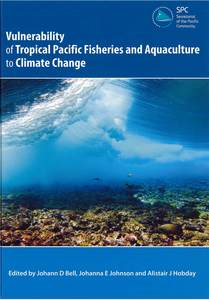Vulnerability of freshwater and estuarine fish habitats in the tropical Pacific to climate change
Gehrke, Peter C., Sheaves, Marcus J., Terry, James P., Boseto, David T., Ellison, Joanna C., Figa, Boga S., and Wani, Jacob (2011) Vulnerability of freshwater and estuarine fish habitats in the tropical Pacific to climate change. In: Bell, Johann D., Johnson, Johanna E., and Hobday, Alistair J., (eds.) Vulnerability of Tropical Pacific Fisheries and Aquaculture to Climate Change. Secretariat of the Pacific Community, Noumea, New Caledonia, pp. 369-432.
![[img]](https://researchonline.jcu.edu.au/19649/1.hassmallThumbnailVersion/19649_Gehrke_et_al_2011_Book_Cover.jpg)
|
Image (JPEG) (Book Cover)
- Cover Image
Download (226kB) |
|
|
PDF (Published Version)
- Published Version
Restricted to Repository staff only |
Abstract
People living in the tropical Pacific have a strong affinity for rivers – an identity that is reflected in local languages. On Kadavu Island in Fiji, for example, river names describe many of the traditional fishing and subsistence activities, such as:
Nubunisici – 'snail pool' a pool where edible freshwater snails (sici) can be found;
Waidoidoi – 'doi stream' where the bark of doi trees, a buckthorn variety (Alphitonia zizyphoides), can be used to tie bundles of fish together;
Wainituva – 'tuva stream' source of tuva or derris vine (Derris trifoliata) roots yielding a poison used to stun and collect fish and prawns;
Nubuniura – 'pool of prawns' Macrobrachium spp.;
Waikana – 'food stream' a river known to contain edible species, a rich source of food.
Throughout the tropical Pacific, from the large rivers in Papua New Guinea (PNG), to the small streams on high islands, freshwater fish and invertebrates contribute to food security. Although the quantities harvested for subsistence are still poorly quantified (Chapter 10), awareness of the reliance on freshwater and estuarine resources is increasing.
There is concern that the freshwater and estuarine habitats in the region that support these subsistence fisheries, by providing areas and structures where fish and invertebrates can reproduce, feed, recruit, grow and migrate, may be vulnerable to climate change. Consequently, the rich culture of people who use these rivers as part of their daily lives may also be at risk.
In this chapter, we describe the nature of freshwater and estuarine habitats in the tropical Pacific, their role in supporting fisheries, and the critical requirements needed to maintain them. We then evaluate the vulnerability of freshwater and estuarine habitats to climate change and consider the interactions between the effects of a changing climate and existing impacts on these habitats. We conclude by assessing the constraints to adaptation, the gaps in knowledge to be filled by future research, and the management interventions needed to help maintain the resilience of freshwater and estuarine habitats in the face of climate change.
| Item ID: | 19649 |
|---|---|
| Item Type: | Book Chapter (Research - B1) |
| ISBN: | 978-982-00-0471-9 |
| Date Deposited: | 21 Feb 2012 00:23 |
| FoR Codes: | 05 ENVIRONMENTAL SCIENCES > 0501 Ecological Applications > 050101 Ecological Impacts of Climate Change @ 100% |
| SEO Codes: | 96 ENVIRONMENT > 9603 Climate and Climate Change > 960309 Effects of Climate Change and Variability on the South Pacific (excl. Australia and New Zealand) (excl. Social Impacts) @ 100% |
| Downloads: |
Total: 1385 Last 12 Months: 7 |
| More Statistics |



